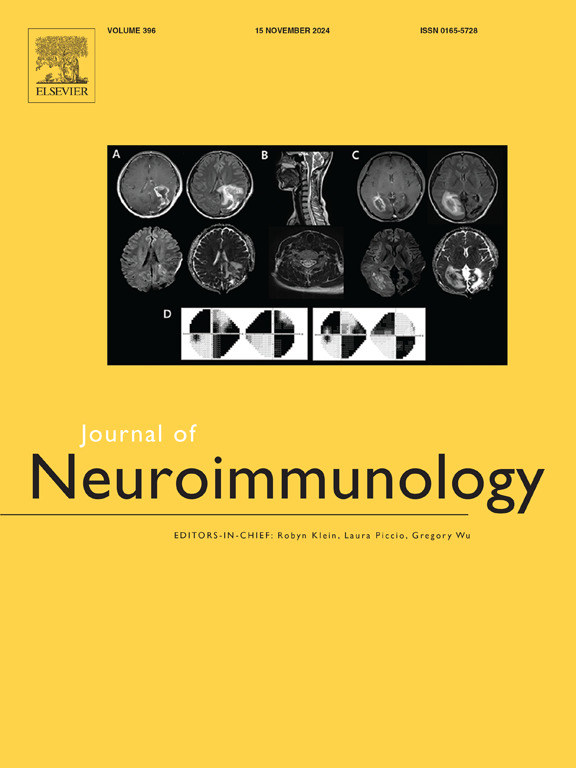Predictors of visual outcome in optic neuropathy of sarcoidosis
IF 2.9
4区 医学
Q3 IMMUNOLOGY
引用次数: 0
Abstract
Background
Up to 25 % of patients with neurosarcoidosis develop optic neuropathy, and prior observational studies have demonstrated a sizeable portion of these patients will remain significantly visually impaired. Despite its major influence on future disability, no prognostic factors are available to predict the potential for visual recovery.
Objective
To evaluate clinical and paraclinical data for their ability to predict final visual outcomes in sarcoid optic neuropathy.
Methods
Between 01/2011 and 03/2023, patients with neurosarcoidosis were included if they experienced an inflammatory optic neuropathy as a symptomatic disease manifestation and adequate clinical details were available for retrospective review. The cohort was divided into those with better (visual acuity better than 20/100) and worse (visual acuity 20/100 or worse) final visual outcomes. Presenting clinical features, radiographic findings, results of ancillary testing, and subsequent clinical course were compared between the two groups to identify factors predictive of final visual outcome. Means and proportions were compared between groups using the two-sample t-test for continuous variables and the Chi-squared test for categorical variables.
Results
36 cases (36/247 or 14.6 % of the total neurosarcoidosis cohort, 17 patients excluded) were included (mean age of visual onset 46.5 ±11.3 years, 24/36 or 66.7 % female, 28/36 or 80 % Black), of which 20 (55.6 %) and 16 (44.4 %) were observed to have better and worse visual outcomes at last follow-up, respectively. The majority had inflammation along the optic nerves in the orbital apex and optic canals (29/32, 90.6 %), predominantly in a perineural fashion in isolation (14/32, 43.8 %) or with enhancement of the optic nerve intrinsically (10/32, 31.3 %). Inflammation outside of the optic apparatus, neurologically or systemically, was almost always present (35/36, 97.2 %). Predictors of future worse visual outcomes included: diagnostic classification of definite (p = 0.03), significantly impaired visual acuity at onset (20/100 or worse, p = 0.001), impaired visual fields at onset (p = 0.004), dyschromatopsia at onset (p = 0.01), optic disc pallor or atrophy at initial evaluation (p = 0.033), and at least one recurrence of inflammatory optic neuropathy over the course of follow-up (p = 0.038). A pattern of optic perineuritis on MRI (p = 0.025) and use of azathioprine as the initial disease modifying treatment (p = 0.027) was predictive of a better visual outcome. Laterality (uni- vs bi-) of visual impairment, inflammatory localization within the visual apparatus (anterior vs posterior, longitudinal extent), associated MRI features (of inflammatory deposits not affecting the visual apparatus), delay in diagnosis, delay in initiation of steroids as an initial treatment, and delay in initiation of the initial maintenance treatment regimen were not predictive of final visual outcomes in this cohort. Mean follow-up duration was 67.5 months.
Conclusions
Predictors of a worse visual outcome at last follow-up included a presenting visual exam with significant deficits (visual acuity, visual fields, color vision, optic disc pallor), a diagnostic classification of definite neurosarcoidosis, and occurrence of relapses. Those with less impaired visual exams at presentation and a perineural pattern of optic nerve enhancement on MRI experienced better visual outcomes.
求助全文
约1分钟内获得全文
求助全文
来源期刊

Journal of neuroimmunology
医学-免疫学
CiteScore
6.10
自引率
3.00%
发文量
154
审稿时长
37 days
期刊介绍:
The Journal of Neuroimmunology affords a forum for the publication of works applying immunologic methodology to the furtherance of the neurological sciences. Studies on all branches of the neurosciences, particularly fundamental and applied neurobiology, neurology, neuropathology, neurochemistry, neurovirology, neuroendocrinology, neuromuscular research, neuropharmacology and psychology, which involve either immunologic methodology (e.g. immunocytochemistry) or fundamental immunology (e.g. antibody and lymphocyte assays), are considered for publication.
 求助内容:
求助内容: 应助结果提醒方式:
应助结果提醒方式:


